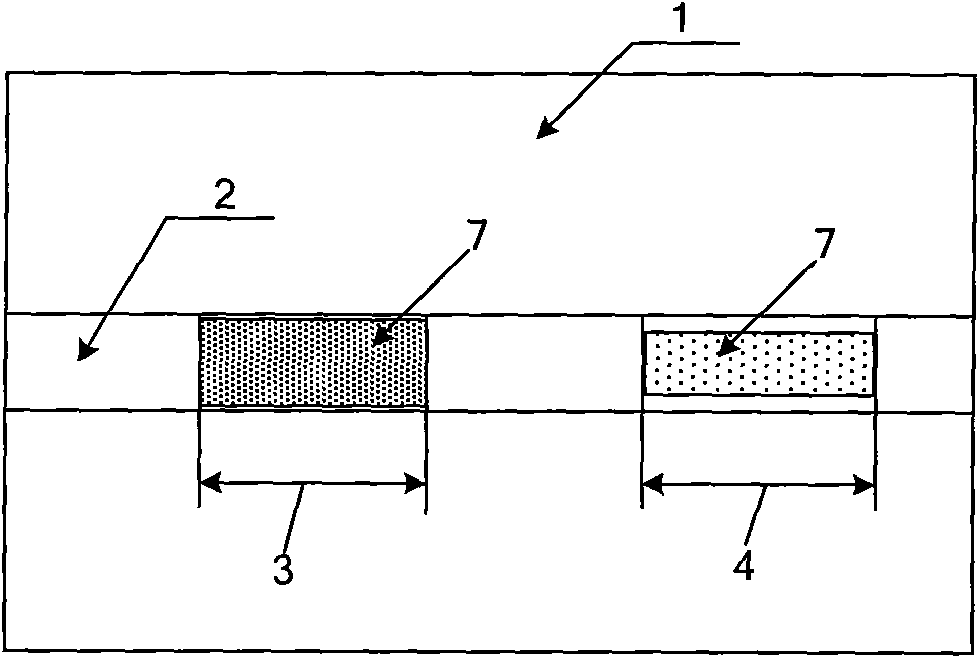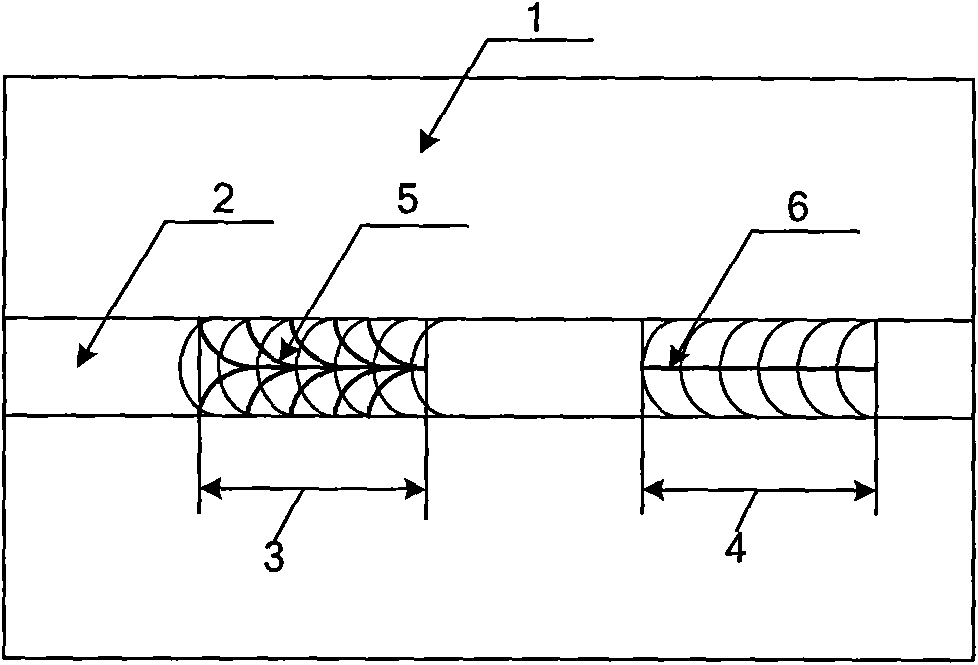Method for manufacturing surface crack defect test block for nondestructive flaw detection
A technology for surface crack and non-destructive flaw detection, which is applied in the preparation of test samples, optical testing of flaws/defects, and analysis of solids using sound waves/ultrasonic waves/infrasonic waves, etc. , to achieve the effect of enhancing perceptual and rational cognition
- Summary
- Abstract
- Description
- Claims
- Application Information
AI Technical Summary
Problems solved by technology
Method used
Image
Examples
Embodiment 1
[0028] (1) Welding test block preparation and filling layer welding
[0029] according to figure 1 As shown in Fig. 1, a bevel is first made on the defect test block 1, and then the welding rod matching the material of the defect test block 1 is used to fill and weld the bevel, and the design crack area is determined on the weld.
[0030] (2) Sprinkle FeS powder on the designed crack area
[0031] Use commercial ferrous sulfide powder 7 (Ferrous sulfide, FeS for short, S ≈ 27%, melting point 1195 ° C), with a particle size range of 20-40 mesh, and spread it on the surface of the weld in the designed crack area.
[0032] Formation of herringbone cracks 5 (such as image 3 or Figure 4 ) The mass ratio of ferrous sulfide powder 7 to the deposited metal on the cover is about 1:10, and the spreading width is the same as the groove width (such as figure 2 A design crack area in 3).
[0033] Formation of the central crack 6 (eg image 3 or Figure 4 ) ferrous sulfide powder ...
Embodiment 2
[0044] (1) Welding test block preparation and filling layer welding
[0045] according to figure 1 As shown in Fig. 1, a bevel is first made on the defect test block 1, and then the welding rod matching the material of the defect test block 1 is used to fill and weld the bevel, and the design crack area is determined on the weld.
[0046] (2) Sprinkle FeS powder on the designed crack area
[0047] Use commercial ferrous sulfide powder 7 (Ferrous sulfide, FeS for short, S ≈ 27%, melting point 1195 ° C), with a particle size range of 20-40 mesh, and spread it on the surface of the weld in the designed crack area.
[0048] Formation of herringbone cracks 5 (such as image 3 or Figure 4 ) The mass ratio of ferrous sulfide powder 7 spreading amount to the deposited metal on the cover surface is about 1:8, and the spreading width is the same as the groove width (such as figure 2 A design crack area in 3).
[0049] Formation of the central crack 6 (eg image 3 or Figure 4 )...
Embodiment 3
[0060] (1) Welding test block preparation and filling layer welding
[0061] according to figure 1 As shown in Fig. 1, a bevel is first made on the defect test block 1, and then the welding rod matching the material of the defect test block 1 is used to fill and weld the bevel, and the design crack area is determined on the weld.
[0062] (2) Sprinkle FeS powder on the designed crack area
[0063] Use commercial ferrous sulfide powder 7 (Ferrous sulfide, FeS for short, S ≈ 27%, melting point 1195 ° C), with a particle size range of 20-40 mesh, and spread it on the surface of the weld in the designed crack area.
[0064] Formation of herringbone cracks 5 (such as image 3 or Figure 4 ) The mass ratio of the ferrous sulfide powder 7 spread to the capping welded metal is about 1:12, and the spread width is the same as the groove width (such as figure 2 A design crack area in 3).
[0065] Formation of the central crack 6 (eg image 3 or Figure 4 ) ferrous sulfide powder ...
PUM
| Property | Measurement | Unit |
|---|---|---|
| Granularity | aaaaa | aaaaa |
| Melting point | aaaaa | aaaaa |
Abstract
Description
Claims
Application Information
 Login to View More
Login to View More - R&D
- Intellectual Property
- Life Sciences
- Materials
- Tech Scout
- Unparalleled Data Quality
- Higher Quality Content
- 60% Fewer Hallucinations
Browse by: Latest US Patents, China's latest patents, Technical Efficacy Thesaurus, Application Domain, Technology Topic, Popular Technical Reports.
© 2025 PatSnap. All rights reserved.Legal|Privacy policy|Modern Slavery Act Transparency Statement|Sitemap|About US| Contact US: help@patsnap.com



